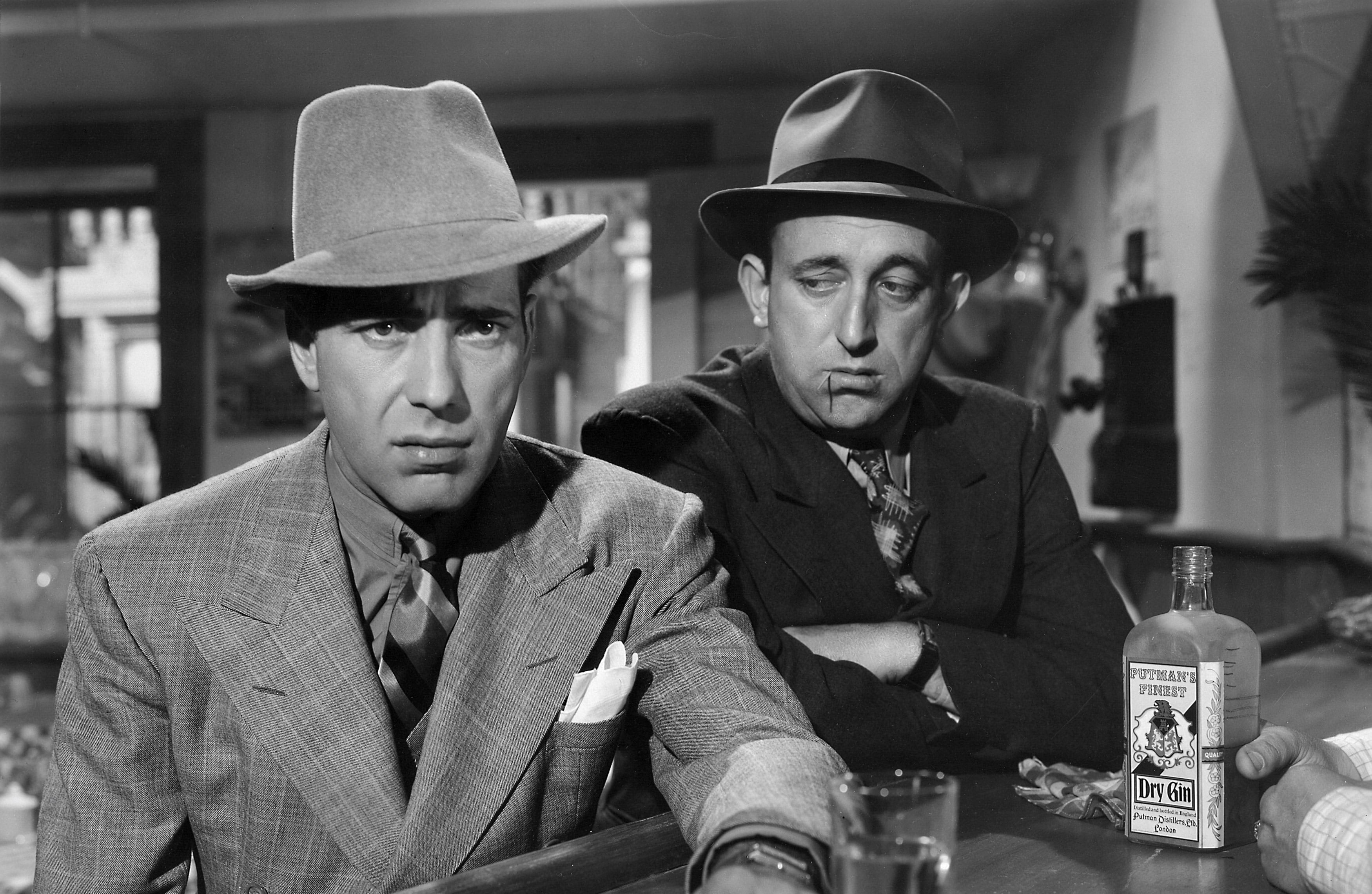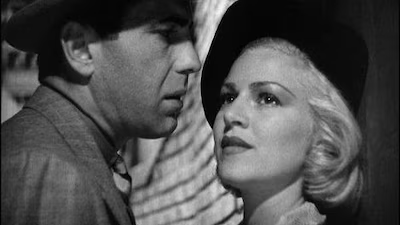Dead End

Brief Synopsis
Cast & Crew
William Wyler
Sylvia Sidney
Joel Mccrea
Humphrey Bogart
Wendy Barrie
Claire Trevor
Film Details
Technical Specs

Synopsis
The East Side tenements of New York have gradually given way to exclusive dwellings of the rich, with the result that many of the poor live next to opulent apartments they can never afford. "Baby Face" Martin, a notorious killer, returns to one such dead end street, his home as a boy, hoping to see his mother, and Francey, an old girl friend. Dave Connell, an unemployed architect, also lives on the street, but dreams that one day he and Kay, the girl friend of a wealthy man, can have a better life. His friend Drina Gordon, who has loved Dave for years, struggles through a strike, hoping to earn enough money to keep her kid brother Tommy from turning into a criminal along with his friends on the street. Martin finds his mother and Francey, but becomes despondent when his mother slaps and rejects him and he learns that Francey is a prostitute. Martin yearns to stay in one place, but, despite plastic surgery on his face, his finger prints cannot be changed and he is trapped by his past crimes. That same afternoon, the street kids beat up Philip, the son of one of the wealthy apartment owners, and take his watch. Although Tommy gives the watch back, the boy's father, Mr. Griswold, the brother of a famous judge, wants to press charges when Tommy wounds him slightly with a knife. Tommy wants to run away, but Drina begs to go with him. When Spit, the leader of Tommy's gang, informs, Tommy hides while Drina talks to the police. Meanwhile, Martin is killed by Dave, who stops Martin's plan to kidnap Philip. Because Dave will now earn a large reward, he thinks that he and Kay can start a new life, but lets her go when he realizes that she is only interested in a year of high living with him. He and Drina convince Tommy to give himself up and, although Mr. Griswold refuses to drop charges, Dave offers to use his reward money to hire a good lawyer to keep the boy out of reform school. As the inhabitants of the street go back to their respective homes, Dave and Drina walk together with Tommy to the police station.

Director

William Wyler
Cast

Sylvia Sidney

Joel Mccrea

Humphrey Bogart

Wendy Barrie

Claire Trevor

Allen Jenkins

Marjorie Main

Billy Halop

Huntz Hall

Bobby Jordan

Leo B. Gorcey

Gabriel Dell
Bernard Punsly
Charles Peck

Minor Watson

James Burke

Ward Bond

Elisabeth Risdon
Esther Dale
George Humbert
Marcelle Corday
Alan Bridge
Robert Homans
Thomas Jackson

Donald Barry

Charles Halton
Esther Howard
Crew
James Basevi
Eddie Bernoudy
Richard Day
Paul Eagler
Samuel Goldwyn
Samuel Goldwyn
Lillian Hellman
Julia Heron
Merritt Hulburd
Omar Kiam
Jock Lawrence
Frank Maher
Daniel Mandell
Alfred Newman
Gregg Toland

Videos
Movie Clip






Trailer
Film Details
Technical Specs

Award Nominations
Best Art Direction
Best Cinematography
Best Picture
Best Supporting Actress
Articles
Dead End
Kingsley wrote Dead End when he was only 29 years of age. It's a classic New York story, capturing the city's social dichotomy where poverty lives under the shadow of wealth and power; an environment where the distance separating the social stratum spans wider than the Brooklyn Bridge, but is separated by only one block. The Dead End Kids are pructs of this urban ghetto and, though only supporting characters in the movie, are clearly representative of the next generation of inner city slum dwellers who remain trapped in an endless cycle of poverty and crime.
The main storyline of Dead End concerns Drina (Sylvia Sydney), a young woman walking the picket line at work and trying to keep brother Tommy (Billy Halop, the only Dead End Kid with a prominent role in the film) out of trouble. She's also in love with Dave (Joel McCrea), an idealistic but unemployed boy from the neighborhood, who has set his sights on a penthouse view complete with a sexy mistress (Wendy Barrie). The real trouble begins when gangster Baby Face Martin (Humphrey Bogart) returns home to visit his mom (Marjorie Main) who wants nothing to do with him. Martin is a bad influence on Dave and has already ruined the life of his ex-girlfriend Francie (Claire Trevor), who is now a prostitute and slowly dying from consumption.
Bogart had originated the Baby Face Martin role on stage. His silk shirt wearing ho-from-the-streets-who-made-go is in stark contrast to McCrea's can't-get-a-break straight shooter. Martin and Dave are the older generation of Dead End Kids, both representing possible outcomes for the youngsters. Bogart would go on to play in two more Dead End Kids movies: Crime School (1938) and Angels With Dirty Faces. There would be seven films in the Warner Bros.' Dead End series total; all featuring big stars like James Cagney and Ronald Reagan with the Kids taking secondary billing.
After Warner was finished with them, the Dead End Kids took up residence at "Poverty Row" studio Monogram as the East Side Kids. Here they made 21 more movies. At the same time, four of the boys (Halop, Hall, Dell and Punsly) ventured over to Universal for 12 Little Tough Guy movies. Finally, it all culminated in what were probably the boys' best features since the original Warner pictures - The Bowery Boys series; 48 movies in all, with Leo Gorcey and Huntz Hall taking over gang command from the departing Billy Halop. By the end of the series, Gorcey and Hall's slapstick comedy shtick had become the focus of their movies, which had little in common with the gritty social realism of their debut feature, Dead End.
Still, even after 80 movies, the Kids were still right there on the East Side of New York. And Dead End, nominated for four Academy Awards including Best Picture, Supporting Actress (Claire Trevor), Art Direction and Cinematography (Gregg Toland), would be remembered as the one that started it all.
Prucer: Samuel Goldwyn
Director: William Wyler
Screenplay: Lillian Hellman; based on the play by Sidney Kingsley
Art Direction: Richard Day
Cinematography: Gregg Toland
Editing: Dan Mandell
Music: Alfred Newman
Cast: Sylvia Sidney (Drina), Joel McCrea (Dave Connell), Humphrey Bogart (Baby Face Martin), Wendy Barrie (Kay), Claire Trevor (Francie), Allen Jenkins (Hunk), Marjorie Main (Mrs. Martin), Billy Halop (Tommy Gordon), Huntz Hall (Dippy 'Dip'), Bobby Jordan (Angel), Leo Gorcey (Spit), Minor Watson (Mr. Griswald).
BW-92m. Closed captioning.
by Stephanie Thames

Dead End
Quotes
Maybe I'm wrong. We all make mistakes, boss. That's why they put the rubber on the ends of pencils.- Hunk
Trivia
This was the first appearance of the Dead End Kids who later evolved into the East Side Kids and later the Bowery Boys.
In order to get past the censors, all references to Francey's "profession" were veiled (although it was mentioned in the original play on which the film was based), even the fact that she was suffering from the late stages of syphilis, which was never mentioned by name.
The play opened in New York City, New York, USA on 28 October 1935 and closed 12 June 1937 after 687 performances. Those originating their movie performances in the play were Gabriel Dell, Huntz Hall, Billy Halop, Bobby Jordan, Marjorie Main and Bernard Punsly. Also in the cast were Leo Gorcey and David Gorcey (playing "Second Avenue Boys"), Joe Downing (Babyface Martin), Dan Duryea, Martin Gabel and Sidney Lumet.
Notes
According to the program for the film's premiere, Samuel Goldwyn dedicated the production "to the children of today, that they May be better citizens of tomorrow." According to the program and a Life magazine article on the film, Goldwyn paid $165,000 for the rights to Sidney Kingsley's play, which ran eighty-five weeks on Broadway. The review of the play in Hollywood Reporter noted that the play had the potential to make a great film. According to information in the file on the film in the MPAA/PCA Collection at the AMPAS Library, Twentieth Century-Fox and RKO both considered turning the play into a film before Goldwyn purchased the rights. According to memos in the file, Joseph I. Breen, director of studio relations, raised some objections to elements of the first script submitted to the office. Breen requested that the line "All cats look alike in the dark" be deleted, as well as two sentences that were to trail off, "son of a-" and "go to-."
Additional suggestions offered to Goldwyn included: the word "bum" should not be used in British prints for the film as that word was British slang for the posterior; no "bronx cheer" should be used; the character "Spit" should not be shown actually expectorating; there should be no scenes of characters stepping on cockroaches; and, "old cans and spilled garbage" might cause offense. Some aspects of the original play were altered before the screenplay was submitted to the Hays Office. In the play, for example, the character Francey has syphillis, however, in the film she says that she is "sick" but her hacking cough indicates tuberculosis. The character Dave Connell, played by Joel McCrea in the film, was a crippled artist named Gimpty in the play. Several of the actors from the Broadway production recreated their roles for the film, among them Marjorie Main, Billy Hallop, Huntz Hall, Gabriel Dell, and Bernard Punsly. Leo B. Gorcey also was in the Broadway play, but did not play "Spit." In the play, Gorcey and his brother David played characters known as "Second Avenue Boys." A number of other actors who appeared in the Broadway version of the play later became well known on stage and in films. Among them were directors Martin Gable and Sidney Lumet, and actor Dan Duryea.
Sylvia Sidney was borrowed from Walter Wanger and Humphrey Bogart was borrowed from Warner Bros. for their roles. The picture was nominated for four Academy Awards, one each for Best Picture, Best Supporting Actress (Claire Trevor), Best Cinematography, and Best Art Direction. It was also named one of the Ten Best pictures of the year by Film Daily Year Book. A thirty minute broadcast based on the film was adapted for the Hollywood Hotel radio program on August 20, 1937 and featured McCrea and Bogart from the film's cast. According to modern sources, Goldwyn had initially wanted to film the picture on location in New York but later decided to recreate the New York streets in the studio in Hollywood. Later, he reportedly complained to director William Wyler that the sets were too realistic and appeared too dirty. Modern sources credit Dead End as a positive turning point in Bogart's career and list him as the "star" rather than Sidney or McCrea. The "Dead End Kids" as the young tough boys came to be known, appeared in many films together during the 1930s and 1940s, variously known as "The East Side Kids," "The Bowery Boys" or "The Little Tough Guys." For additional information on their films, consult the Series Index and entry above for Crime School.
New York City's Lincoln Center hosted a special fiftieth anniversary showing of Dead End on February 2, 1987. Although flu prevented Sidney, McCrea and Trevor from attending at the last minute, Dell and Hall attended, as did playwright Kinsgley and Sidney Lumet. Modern sources list the following additional cast members: G. Pat Collins (Detective), Walter Soderling (Coroner), Wade Boteler, Bill Pagwell, Jerry Cooper, Kate Ann Lujan, Gertrude Valerie, Tom Ricketts, Charlotte Treadway, Bud Geary, Sid Kubrick, Frank Shields, Maud Lambert, Lucille Browne, Earl Askam, Mona Monet, and Gilbert Clayton.

Miscellaneous Notes
Released in United States 1937
Released in USA on video.
Released in United States 1937














